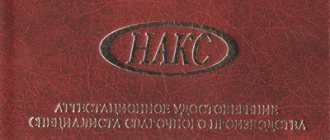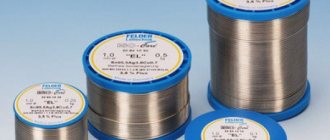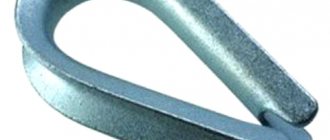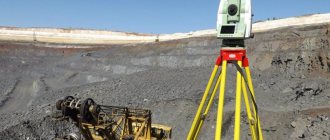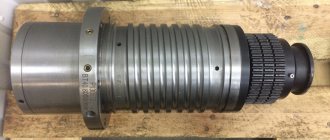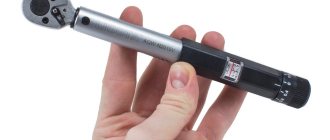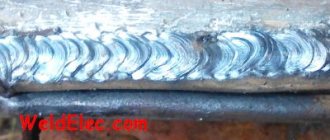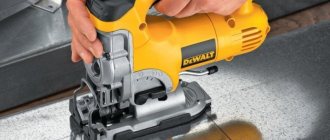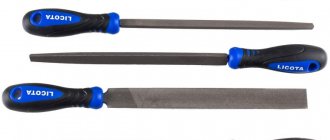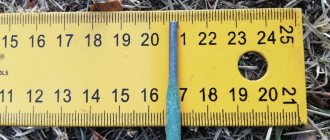Working with thin metal at low currents is difficult. Even experienced welders are not immune to arc rupture, electrode sticking, and uneven seams. When you are dealing with a device equipped with the “Arcforce” option, such difficulties do not arise. Voltage surges that occur when the electrode sticks are smoothed out. In essence, arc forcing on an inverter is a current stabilizer operating in automatic mode. It helps maintain the heating of the additive, facilitates welding of seams, and maintains the arc in one mode. For beginners, this option is a godsend.
Why is arc force needed on a welding inverter?
Unlike a “hot start,” it maintains a stable current not only during ignition of the electrode, but also throughout the entire welding process. The principle of Arc force is to increase the output current during a short circuit. When a drop of metal appears between the electrode and the surface to be welded, there is a high risk of the electrode sticking; it is attracted to the surface to be welded. The device instantly adds amperage to 1/3 of the operating voltage, allowing the drop to melt, and then returns it to its previous parameters. What is arc force of a welding inverter in terms of functionality: a high-speed amperage regulator that stabilizes the operating parameters of the device. Afterburner functions:
Antistick
Contrary to popular belief that the anti-stick or anti-stick function prevents the electrode from sticking during welding - this is not the case. The Arcforce function prevents the electrode from sticking; we talked about it above. When sticking (sticking) of the electrode to the metal occurs, a welding current much greater than the rated one begins to pass through the electrode (i.e., a “short circuit” mode practically occurs); as a result, the electrode becomes hot, and then it is impossible to tear it away from the workpiece, and about further welding with this electrode is out of the question, because... all the coating falls off from it. If the welding machine has the “Anti-stick” option, then when the electrode “sticks”, the welding current and voltage are reset to “0” and the electrode can easily be torn off from the workpiece and comfortably continue welding work using the same electrode. In some welding machines, “anti-stick” can be controlled by adjusting it over time or turning it off altogether.
How to set the welding current correctly
Hello everyone. We continue to analyze our welding diary, and today I want to discuss such an important topic for beginners in welding, how to correctly set the welding current? Because this is one of the most important components of obtaining normal penetration of the parts being connected. I'll start with the bad news. Many of our household welding inverters produce less welding current than stated in the instructions, unfortunately this is the case. So if you install a current twister of 100 amperes, in fact there will be less. A simple conclusion follows from this - when setting the current, you do not need to rely on the tables and regulator (knob!) of your device.
Welding arc afterburner. What is it and how to use it
Welding arc afterburner - an assistant for beginners
On some welding machines you can see the inscription on the control panel “Arcforce”, which means “welding arc force”, and a nearby regulator. In Russian this means forcing. This function in inverters is responsible for preventing the electrode from sticking to the surface being welded. To do this, the device, at the right moments, automatically adds the required current, which compensates for the operating voltage, regardless of the set number of Amperes before starting welding. Where is this feature applicable and how useful is it?
Operating parameters of the device - high performance at an average cost
The main characteristics that determine performance are as follows:
- welding current is adjustable in the range from 15 to 180 A, deviations from the maximum value at rated voltage (220 V) do not exceed 10 A. LO (load duration) with a welding cycle of 5 minutes - 35% (180 A), 50% (160 A ), 100% (140 A);
- the operating voltage is 140 - 250 V. This is an impressively wide range, allowing 3 mm electrodes to work effectively even with a very strong network drawdown;
- weight and dimensions - 4.3 kg and 295 × 155 × 160 mm, respectively. The weight and size characteristics are small, so it is quite convenient to transport and work with the inverter;
- power consumption is about 6.2 kW. Autonomous operation requires powerful professional generators, since ordinary household devices cannot cope with such consumption.
Popular models with hot start function
The most popular inverter devices equipped with a hot start function include the Resanta SAI-250 65/6 model. This unit is intended for professional use and can work with electrodes up to 6 mm thick. Overheating protection has been implemented. The welding current is adjustable in the range from 10 to 250 A. Despite the excellent functionality, the welding unit weighs only 5 kg. You can buy a model for up to 11,000 rubles.
FoxWeld Master 202 is a professional-class welding machine, the cost of which does not exceed 14,500 rubles. This is a reliable assistant in a small enterprise, construction site, workshop or garage. The model is often chosen for use in households. Such useful options as hot start, anti-sticking, and arc force have been introduced here. Device weight: 6.3 kg. The device is equipped with a display that displays operating parameters. The build quality is excellent.
The list of popular models also includes Fubag IR 180. In the manufacture of the welding machine, the manufacturer used the most modern technologies and equipped the device with high-precision electronics. The price is quite affordable - 9,000 rubles. The model with an air cooling system and protection according to the IP21S standard copes with the assigned tasks perfectly. The maximum current is 180 A. The unit weighs only 5 kg. The model is equipped with a display. In addition to hot start, there is also arc forced and anti-stick.
How to use arc force?
Experts recommend using this mode only in cases where you have to work with thin products, since otherwise they will be useless. If the device has a simple functional basis that does not require parameter adjustment, then before direct welding it is enough to turn on the appropriate mode. But this scheme often does not justify itself, since it cannot adapt to the parameters if welding occurs with different types of electrodes. Thus, if you want to figure out how to properly regulate arc force, it is worth understanding that its parameters will depend not only on the thickness of the metal, but also on the type of welding electrodes used.
Other inverter options
One of the capabilities of a welding inverter is welding wires. Yes, yes, wires, you understood everything correctly.
Many who connect wires by twisting and further welding use specially designed devices for these purposes, assembled on the basis of a step-down transformer. However, as practice shows, a conventional inverter for welding copes with this task no worse.
All you need to do is install a carbon brush instead of the electrode. You will need a fairly large brush, but you can use a power tool. A few alterations, and here in front of you is a real machine for welding wires.
What is arc force when welding with electrodes
Sometimes during the welding process, especially if it is performed by an inexperienced welder, the electrode “sticks” to the product. Since a drop of metal accidentally separates from it. As a result, the length of the working arc is sharply reduced, causing an interruption of the welding process. To eliminate this situation as much as possible, many manufacturers of welding equipment have equipped their machines with the “Arc force” function.
When a drop of metal accidentally separates from the electrode, causing it to “stick” to the workpiece being welded, the welding unit automatically increases the operating current for a very short period of time. How to force the arc, which reduces the likelihood of the electrode “sticking” during welding.
This automatic adjustment of “forced working arc” makes it possible to change one of its parameters – “stiffness”. As a result, a “softer” arc is established, ensuring minimal splashing during fine-droplet transfer.
Another option is to force the operating mode - ensuring penetration of the seam of the welded joint to a greater depth.
Arc welding. Stick electrode welding (MMA). Which welding inverter should I buy?
Review of inverters Pro ARC 200 and Pro ARC 250.
The small-sized welding inverter Pro (Rilon) of installation class is designed for manual arc welding with a stick electrode using direct current. Recommended for professional use. Welding inverter Pro (Rilon) is widely used for welding carbon, low-alloy and stainless steels.
Welding machines are intended for installation work on objects for various purposes, repair work (housing and communal services, emergency repair teams), production of welded metal products (trusses, beams, supports, columns, fences, fences, gates, stairs, railings), private households ( garage, dacha).
Let's take an example of two welding inverters Pro ARC 200 and Pro ARC 250, namely the design and features of the front panel of these devices.
To make it easier to set the welding current, the front panel is equipped with a digital display on which the welding current value is displayed when the welding current potentiometer is rotated. Around the welding current potentiometer there is a scale indicating the electrode diameters. For beginners, this will make it much easier to adjust the welding current to the selected electrode diameter. The article How to choose an electrode for MMA welding will help you choose welding electrodes yourself.
To facilitate the work process and improve the quality of welding, the devices have auxiliary functions:
HOT START function (hot start)
To ensure better ignition of the arc at the beginning of welding, an inverter equipped with the HOT START function produces an automatic short-term increase in the welding current. This makes it much easier to start the welding process.
ARC FORCE function
Adjustable with Arc Force potentiometer. During the welding process, a drop of metal separates from the electrode, which sharply reduces the length of the arc, and the electrode can weld to the product (stick). An inverter equipped with the ARC FORCE function forces the arc, automatically increasing the welding current for a very short period of time, which reduces the likelihood of the electrode sticking during the work process. Adjusting the arc force allows you to change a parameter such as arc rigidity. This can achieve either a softer arc, which will provide low spatter during small droplet transfer, or, by increasing the forcing parameter, obtain deep penetration of the weld (hard arc).
ANTI STICK function (anti-sticking).
When starting welding, the arc must be ignited. This often leads to the electrode sticking to the product. The inverter, equipped with the ANTI STICK function, automatically reduces the welding current when the electrode sticks. Subsequently, after the stuck electrode comes off, the inverter resumes the set welding parameters.
So, when setting the welding current, we can also set the arc force. For stable and high-quality welding, it is best to set these parameters to the same positions. Using the Profi ARC 200 as an example: if we leave the arc force in a quiet position and set the welding current potentiometer to maximum, then the maximum working diameter of the electrode will be 3 mm. Thus, for correct operation of an electrode with a diameter of 4 and 5 mm, we will need to adjust the arc force.
Profi inverters use cable sockets designed for current values exceeding the declared parameters, which makes it possible to increase the service life of inverters as a whole.
Pay attention to the package. The devices are equipped with an electrode holder assembled with a three-meter welding cable, a cable plug and a terminal (ground) assembled with a three-meter welding cable and a cable plug.
The Pro ARC 200 comes in two configurations: with an aluminum case and without a case. The complete set with a case is convenient for carrying and storing the welding machine.
You can find prices for welding inverters in this section.
Why is welding arc afterburner needed?
The use of this mode is necessary to create the simplest possible conditions for obtaining a connection in order to ensure high quality seams. Devices with this function can already be classified as professional. They have a noticeably higher cost and are suitable for a wide range of jobs. If high quality standards are put forward for the connection being made, then it is worth welding with such an additional function. Even a beginner can handle welding thin items without the constant sticking that even experienced welders encounter. It is for this reason that if the question arises which is the best inverter welding machine to choose, you should pay attention to such options. There are a variety of options on the market. Officially, welding arc force is designated Arcforce. If this inscription is present on the case under certain sensors or regulators, as well as when the model is indicated in the marking, you can be sure that this is exactly what you need.
It is worth noting right away that this mode is not for constant use. It is mainly needed for delicate work, especially since its settings are designed for just that. If the model of the device is designed to adjust the parameters, then the capabilities of the technology increase and it can be used in a greater number of cases. But this also entails an increase in the cost of the welding machine. Technology with an unregulated mode appeared earlier. It is easier to use and, accordingly, costs less.
Domestic welding machines of the Start brand, originally from China
The market for building materials and tools has recently changed significantly. It is gratifying that domestically produced products have appeared. In addition, the stereotype about low-quality Chinese goods is gradually breaking down. In the post-Soviet period, mass consumers paid attention to European products. Indeed, for a long time it had no competition. The development of Russian manufacturers began in the period from 2008 to 2010. It was at this time that many merged enterprises appeared.
European countries did not want to lose such a market as Russia, but the price of imported goods is much higher than the price of domestic brands. As a result of competition, companies have appeared in Russia that produce European goods using licensed technologies. This significantly reduced the cost of production, but pushed the true Russian manufacturer to look for more profitable solutions for itself. One of these solutions is to open enterprises at Chinese facilities.
Products with the START brand
The passport of devices from the Startweld company states that they were manufactured in China, but the welding equipment is generally considered to be domestic. China just offered its factory. As a result, the company’s management decided to set up production in China rather than start construction from scratch in Russia. Today, such practices are found at every step.
The company specializes in the production of modern and multifunctional inverter welding machines. These are devices for argon-arc welding and plasma cutting, semi-automatic machines and inverters for manual arc welding. The list of categories does not end there. Startweld presents all the necessary equipment, including accessories.
Optimal temperature range for operating inverters
As you know, the higher the air temperature, the faster the inverter protection is triggered. As a rule, the technical characteristics of welding machines state that the maximum ambient temperature for operating the inverter is 40 degrees. WITH.
Often, when there is an overload, the overload light on the inverter lights up, as a result of which it simply does not start for some time. Many welding machines have this quality, and this quality is useful. However, if the device turns on and starts operating under overload conditions, then condensation is likely to form inside the case, which, in turn, will lead to damage to the internal components.
general information
Anyone who has been trained in welding knows that one of the main problems for a beginner is difficulty in burning an arc. We will even say more: from time to time the arc can burn unstably even with an experienced master. This is due to many factors: from the physical well-being of the welder himself to an incorrectly selected welding mode.
But for beginners, the cause of the problem is usually always the same: using minimal current. Beginner welders set the welding current to a low value to avoid burn-through. But because of this, it is not possible to ignite the arc normally and hold it stably throughout the entire welding.
To solve this problem, you need to select the correct welding mode and ensure that the electrode does not stick to the metal. As you understand, it’s not easy for a beginner to do everything at once. All the more correct. Therefore, additional functions come to the rescue. Such as arc force.
Arc force is designed to speed up and simplify welding work. This function stabilizes the arc at any current value. The essence of arc forcing is simple: this function automatically adjusts the current parameters to the conditions in which you work.
Let's give a simple example. You set the minimum amperage in the hope of no burn-through and started welding. During the work, the electrode began to stick to the metal. If your inverter has an arc force function and you turn it on, a short circuit will occur and the current will automatically increase to the optimal value. And then it will return to the original settings, and you can cook at the amperage you set.
Arc force can be automatic or customizable. In budget models it is usually automatic. Turns on by pressing one button. This mode is most suitable for beginners, but experienced welders need deeper settings.
Hot Start
Hot start, hot start or Hotstart are all the same concepts. What is this option? To describe it in a nutshell, this is an additional surge of welding current at the moment the electrode touches the workpiece. For example, if we have set the welding current to 150 Amps, then at the moment of touching and igniting the electrode, if the welding inverter has a “hot start” function, the welding current should briefly increase by a certain amount. This value may differ for different manufacturers: 5, 10, 15, 30,... 100% of the set welding current. For some welding inverters, the hot start current has a fixed value and cannot be adjusted, sometimes it can simply be turned off (this makes sense when welding thin metals to avoid burns), there are inverters in which the “hot start” can be smoothly adjusted from 0 to 100 %.
Hotstart helps in igniting bad electrodes, when welding rusty metal, in case of poor mains voltage and in many other cases. It is best when the welding inverter has an adjustable hot start, and you can adjust it yourself depending on your needs.
Brief information
Professional welders are familiar with the basic difficulty of a beginner - difficulty in burning an arc. At times it functions unstable even for a professional.
This is associated with a significant number of conditions: from the health of the master to an incorrectly configured welding mode.
Beginners often have one problem: using minimal current. Inexperienced craftsmen set a small welding current to avoid burn-throughs.
But because of this, it is not possible to light the arc well and constantly hold it during the entire welding.
To resolve this issue, you need to set the welding mode correctly and ensure that the electrode does not stick to the metal. A debutant cannot do everything correctly. In this regard, they resort to auxiliary parameters, for example, arc force.
His calling is to make the process faster and easier. It normalizes arc burning at any current strength. Its essence is obvious: with automatic settings, it adjusts the current value to the parameters at which you perform welding.
For example, you have set the lowest current and are performing a welding process. During welding, the electrode begins to stick to the metal. When this parameter is enabled, a short circuit will occur on the inverter.
At the same time, the current strength will increase to the ideal value. And then it will return to the original values and you can continue welding at the set amperage.
Arc force can be automatic or customizable. In cheap devices it is often automatic. Activated by pressing a button. This is great for beginners, but professionals need to set up the equipment more carefully.
Peculiarities
So, the afterburner function stabilizes the arc, simplifies and speeds up work. Previously, this feature was only found in professional-grade inverters. But recently the technology has become more accessible and manufacturers have begun to introduce arc afterburner even in inexpensive models. Thanks to this innovation, a relatively budget inverter can be used for serious work.
But keep in mind that arc forcing in a professional device works much better and produces a better result. Therefore, if you plan to perform particularly important work, then it is better not to save on an inverter. Usually in inverter documentation this function is called “Arc Force”. This inscription can also be found on the body of the device itself.
Arc force can simplify the work so much that even a novice welder can perform welding at a decent level. Even with a lack of experience, you can weld parts made of thin metal, without defects or sticking electrodes. But these problems are often encountered by professionals who rely only on their own strengths and do not use modern functions in the device.
Remember that the arc force function is not a panacea for all ills. To achieve good quality seams you need to have at least basic welding skills. No additional functions will help you if you don’t know how to light an arc, make a seam and do the job quickly.
Also keep in mind that the arc force function reveals itself fully only when working with parts made of thin metal. For some models it is possible to adjust the function parameters. Then, of course, you can weld metals of different thicknesses. But this is possible only in expensive professional devices. Most models simply have an on/off button with preset parameters. Therefore, do not turn on the arc force just like that. Failure to use this function correctly can damage the quality of the seams.
DC welding machine: how to regulate arc current?
It is not customary to put a question mark in the title. But I am forced to act differently: I need to ask advice from knowledgeable people, I need technical help. The fact is that I published an article on the site where I described an original DC welding machine made by myself. They read it and ask questions. The control diagram looks like this.
One welder from Magadan named Pavel asked for help with the design of a welding machine in which the arc current can be adjusted. He works in an emergency team, dealing with the elimination of gas breakthroughs from a gas pipeline. The location and time of the accident is unpredictable. They get there on a tracked all-terrain vehicle, but it often can’t get close: there are hills and swampy terrain. Carrying a 100-kilogram welding generator several hundred meters through a swamp is another task... And at this time the walkie-talkie breaks, gas comes out through the fistula... For the first time, Pavel adapted to grab the batteries from the all-terrain vehicle under his arms and run to the scene of the accident. Assembles a 36 volt battery on site, connects the hoses and works. You have to cook in very short sections: the arc current is high. Thanks to skill, the fistula is eliminated, and then the generator is dragged to the place of the breakthrough and the stitches are restored to their normal appearance. All this is stated in the comments to the article, and we also communicate additionally on VK. He asked me: is it possible to regulate the arc current from the batteries using my thyristor circuit. I explained that this cannot be done: I work with rectified current formed by ripples from the semiharmonics of a sinusoid. The thyristor opens when current is supplied through the control electrode chain, and closes when the downward harmonic branch reaches zero.
It is not difficult to open a thyristor in a DC circuit, but it is impossible to regulate the load size. Initial data for calculating the design The battery voltage is sufficiently 36 volts, although Pavel experimented with 48: the current is even greater, it is more difficult to cook. The arc from its electrodes ignites normally. Welding current is needed in the range of 70-110 amperes. I suggested that he control the temperature of the battery electrolyte electronically: there had already been a can explosion due to boiling vapors. We considered three adjustment options: 1. an electronic circuit based on bipolar transistors; 2. connecting ballast resistors; 3. a circuit for converting direct current into alternating current 220 volts and connecting a welding inverter. Circuit using bipolar transistors The option of reducing the arc current by reducing the voltage should be suitable, but it is difficult to implement it for the given parameters. Not a single transistor can withstand such a current, and soldering and setting up a circuit from components is not a promising task for a welder without skills in working with electronics. I have in my old stock several Soviet TK-152-100 100 ampere transistors, but they are designed to operate in pulse mode. Hardly suitable for welding. This option was abandoned. Limiting the current by ballast resistance Here you need to understand that there is no rheostat for 100 amperes, and if you make one, then there are even a lot of theoretical questions. The weight alone will cost a lot, and you won’t be able to find suitable material. The design of the water rheostat somehow does not inspire confidence... We settled on a single ballast resistance. Pavel found something suitable and experimented: the current decreased a little, the result improved a little, but it’s not particularly pleasing. Inverter We picked up an inverter from Ali in China that produces pure sine wave at 220 volts with a power of 4 kW. Should be enough. Pavel has a welding inverter, which is quite enough for him. However, there is only an electronic circuit using CMOS transistors, and to convert a sine wave you need to connect a 36 or 24 to 220 transformer. And you also need a choke to it.
So the extra weight is gained again. Winding a transformer is not difficult. I described this technology, including the calculation of the magnetic core and wires, in an article about a homemade soldering iron Moment. I added some things in answers to questions in the comments. There are already more than 140 of them there. Pavel has no desire to wind the transformer and choke. He needs a ready-made solution. That’s why I ask: maybe you know how to help Pavel solve his problem: create a lightweight DC welding machine powered by car batteries? It is needed for emergency removal of fistulas in the gas pipeline. Please express your thoughts in the comments section on the channel or website. I would be grateful for your help. If you don’t know the exact answers, but want to help, then just share the article with your friends on social networks. There may be specialists among them. Source
Arc Force function: what is it for?
There are a number of welding jobs that are performed at low currents. These include the following:
- welding of thin sheet steel;
- weld root penetration during pipeline welding and multi-pass welded joints.
In such cases, increased attention and considerable experience are required, since when working at low current, sticking of the electrode is often observed, and one careless movement of the welder can cause a burn through the base metal.
It is for such cases that the “Arc Force” option was developed, which is equipped with most modern inverter devices.
In some inverters, this function is built-in - that is, it works automatically and is not regulated. But on professional models with more precise settings of welding parameters and additional functionality, the welder can independently enable and adjust the values of the “Arc Force” option (more or less).
What is Vrd?
WFD
- an abbreviation, can have the following meanings:
Air-breathing engine;
Valve jet motor
Interesting materials:
Is it possible to run the day after strength training? Is it possible to run with a hangover? Is it possible to fight enlarged pores? Is it possible to pick up an axolotl? Can I clean contacts with cologne? Is it possible to cleanse lymph? Is it possible to give barberry to children? Is it possible to give halva to children? Is it possible to let clay dry? Can I give my Privatbank card number?
